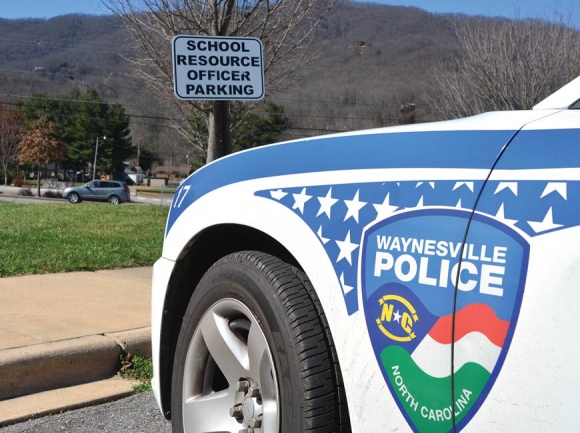Never again, again: School safety could be beyond the reach of counties, states
 While welcome, more school resource officers aren’t necessarily the answer to school safety issues, according to Interim Haywood Schools Superintendent Dr. Bill Nolte. Cory Vaillancourt photo
While welcome, more school resource officers aren’t necessarily the answer to school safety issues, according to Interim Haywood Schools Superintendent Dr. Bill Nolte. Cory Vaillancourt photo
In April, students at Santa Fe High School southeast of Houston walked out of classes to protest gun violence in the wake of the Parkland, Florida, school shooting Feb. 14.
Weeks later eight of them are dead, along with two teachers.
The May 18 Texas shooting keeps American schools on pace to average more than one school shooting a week so far through 2018.
“I think you have to take it seriously,” said Chuck Francis, chairman of the Haywood County Schools Board of Education. “You can’t say, ‘Haywood County is a rural county and no one’s gonna do that here.’ If anybody’s thinking that way, they’re wrong.”
But as local school districts react to an increasing focus on security, some are finding that they can only do so much.
Related Items
No guarantees
There’s no one magical solution to the school safety issue according to Interim Haywood Schools Superintendent Dr. Bill Nolte, “but there are some really good things you can do.”
Nolte’s comments could barely have been more timely, as they came almost two weeks before the shooting at Santa Fe and almost two months after a school-sanctioned walkout by Haywood students was thwarted by mother nature.
The problem, however, isn’t limited just to public schools like those Nolte oversees as interim superintendent.
“We’ve certainly had shootings in lots of places — public schools, private schools parochial schools, movie theaters, concerts, workplaces, urban settings, rural settings — and people have certainly used things other than firearms to hurt people,” he told Haywood Commissioners May 7 during a school safety update. “So it’s very important to remember that harm to our students could come in in lots of forms and fashions.”
A career educator, Nolte said he remembers the grim lessons learned after mass shootings going back almost 20 years.
“I remember Columbine,” he said, adding that protracted attacks of that sort are no longer as common. “Now it’s one of those ‘first five minutes situations.’”
From Sandy Hook, Nolte said he learned that even locked doors and security cameras won’t stop someone bent on doing harm.
“While those things are very important and we need those and we have those in some of our schools, it’s not a guarantee,” he said.
But perhaps the most striking lesson of all came from the Parkland shooting.
“In [the Parkland shooting] at Stoneman Douglas, we learned that it’s not a problem that can be handled by schools or probably by one government body,” he said. “It’s very, very complicated.”
Reactive vs. proactive
Haywood County Schools does about as much as it can to be prepared for a crisis of the type that recently befell Santa Fe, including regular updates of crisis management plans and as annual training sessions for administrators in conjunction with local law enforcement.
“That work across agencies is just invaluable,” Nolte said. “Everyone has a job. Some are directing traffic, some are housing the incident command center, others are trying to protect students.”
There are also a minimum of three lockdown drills each year in Haywood’s schools, but some other measures are far more costly, and may not even work.
“We need to be sure we’re implementing practical solutions,” Nolte said. “It’s really easy to get emotional and spend several million dollars that can easily be worked around by someone who is ill-minded or intends on hurting someone.”
For example, Nolte said that doors, gates and fences not only don’t guarantee security, they can actually pose a security risk.
“A lot of problems occur within, usually someone that knows the school, so I’m a little concerned about a fence around every school, because then you’d have to screen each individual coming in to make sure they didn’t have something, and in a crisis situation you want to keep bad people out, but you also want good people to be able to get out.”
As another example of solutions that only address physical security, Nolte cited school resource officers.
“There are calls for more school resource officers and we would love to have them, but as I think I said in our work session, there may not be enough property tax money in Haywood County to take care of every safety need,” Nolte said.
Currently, Tuscola, Pisgah and Central Haywood high schools all have their own SRO, as does Waynesville Middle School, but Bethel and Canton middle schools have to share one.
“We love our five,” he said. “And we have added one more to the local current expense budget, but SROs can’t solve every problem, either.”
A statement by Haywood County Sheriff Greg Christopher back in March indicated he was exploring the possibility of creating a program that would see armed volunteers with military or law enforcement experience guarding schools, but Nolte said regulatory framework and liability issues were still nebulous, so it’s gone nowhere.
Francis agrees that more SROs would be welcome, but also sees the problem with reactive, as opposed to proactive, solutions.
“I’ve watched the news and listened to some experts, according to what I’m gathering from the info coming out on [Santa Fe], even with an armed SRO, you lost 10 lives,” he said. “By the time they were able to respond to the shooter, they lost 10 lives.”
Help from above
On the local level, Nolte said some of the practical solutions are within reach, but many of them or not.
A self-proclaimed “gun guy,” Nolte said that some gun control is certainly part of the equation.
“We also need some teeth, I think, probably in legislation and in the courts to make sure that some folks really can’t get access legally to firearms,” he said. “And that’s the trick — I’m a gun guy, so I’m not certainly against firearms, but there are a few folks that we need to make sure can’t get their hands on them, and again I think that’s beyond the role of the commissioners.”
Banning some from legally acquiring firearms may be helpful, but then again it may not; it wouldn’t have stopped the last two school shootings, nor would it have prevented what happened at Sandy Hook or Columbine.
“While gun control is not the answer, the best and most effective path forward, I believe, is one that safeguards our schools from becoming ‘soft targets,’ or areas with little to stand in the way of someone with bad intentions,” said Western North Carolina’s congressman, Mark Meadows, R-Asheville. “We owe it to our kids to give them the safest environment possible.”
Meadows recently introduced a flurry of bills designed to address school safety primarily through SROs, but didn’t respond to questions about another of Nolte’s wishes — better communication in the community about students who display potentially dangerous behaviors.
“We need the ability to communicate more personal information, I think, among community agencies about people who have been repeatedly aggressive and have demonstrated that and had a long record of that,” said Nolte. “We can do that legally in the moment of crisis, but if we see someone who has hurt people for a long, long time it’s hard to talk to law enforcement and other agencies about them, given our current federal laws, unless there’s a crisis at hand.”
Finally, Nolte said, schools should have more leeway in getting rid of potentially dangerous students.
“We need the ability to remove people who are willfully and intentionally aggressive, that have a long history of that. I’m not talking about mental illness… I’m talking about people who for a long time have threatened to hurt people,” he said. “I think that would probably take some legislative changes at a federal level. When those folks are identified, they are liable to be, in my opinion, a perpetrator. So we need to be able to remove those folks.”
Nevertheless, Francis and Nolte remain realistic about just what they can do on the local level.
“We have to keep all options on the table as to what we can do,” Francis said.









